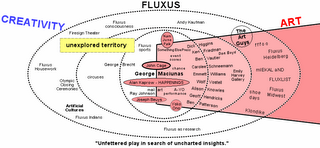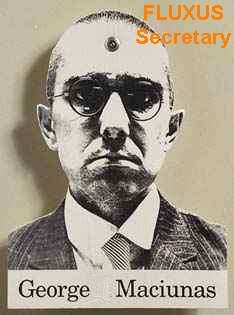Fluxus





O Movimento Fluxus foi um grupo de artistas de várias nacionalidades que colaboravam entre si na Europa, EUA e Japão durante a década de 60. Estruturado ao redor da figura de George Maciunas; um artista lituanês, radicado nos Estados Unidos, o Fluxus desenvolveu uma atuação social e política radical que contestava o sistema museológico através de performances, filmes, música experimental e de suas publicações (Editora Fluxus Inc).
O termo ‘Fluxus’ foi originalmente criado, por Maciunas, para ser o título de uma revista que teria com objetivo publicar textos dos artistas da vanguarda, muitos dos quais tiveram seus trabalhos apresentados, entre 1960 e 1961, no estúdio de Yoko Ono e na AG Gallery de Maciunas, ambas em Nova York. Todavia, ‘Fluxus’ passou a designar e caracterizar um série de performances organizadas por Maciunas na Europa durante três anos (1960-1963).
Essa apresentações foram prolongadas tornando-se festivais – Festum Fluxorum – que percorreram várias cidades como Copenhague, Paris, Düsseldorf, Amsterdã e Nice.
As performances e happenings realizados pelo grupo, bem como suas publicações, e vídeos tiveram um profundo impacto nas artes das décadas de 60 e 70 a partir de sua postura radical e subversiva – ainda que raramente política – na medida em que trabalhava com o efêmero, misturando arte e cotidiano, visando destruir convenções e valorizar a criação coletiva.
O grupo marcou um momento de experimentação comum entre artistas da Europa e América do Norte, possibilitando a afirmação da idéia de coletividade como distintiva das proposições artísticas posteriores, no campo da música e artes experimental.
*From wikipedia:
Fluxus (from "to flow") is an art movement noted for the blending of different artistic disciplines, primarily visual art but also music and literature. Fluxus is often described as being Intermedia because it occurs at the intersections of different media. Fluxus was loosely organized in 1962 by George Maciunas (1931-78), a Lithuanian-born American artist. In its early days Fluxus artists were active in Europe (especially in Germany), America, and Japan.
Today there are Fluxus artists active throughout the world. While there is no longer a large Fluxus community in any single urban center, the rise of the Internet in the 1990s has enabled a vibrant Fluxus community to thrive in virtual space. Some of the original artists from the sixties and seventies are also active in online communities, and many other artists, writers, musicians, and performers have joined them, and have built new Fluxus communities in cyberspace. Fluxus artists also continue to meet in cities around the world to collaborate and communicate in "real-time" and physical spaces.
The art forms most closely associated with Fluxus are Event Scores and Fluxus Boxes. Fluxus Boxes originated with George Maciunas who would gather collections of his printed cards, games, and ideas, and put them into small plastic boxes. Event Scores are essentially performance scripts that are usually only a few lines long and consist of descriptions of actions to be performed rather than dialogue. Other forms which have been adopted by several Fluxus practitioners include collage, audio, music, video, and poetry — especially visual poetry and concrete poetry.
Among its associates were Joseph Beuys, Dick Higgins, Nam June Paik and Yoko Ono who explored media ranging from performance art to poetry to experimental music to film. They took the stance of opposition to the ideas of tradition and professionalism in the arts of their time, the Fluxus group shifted the emphasis from what an artist makes to the artist's personality, actions, and opinions. Throughout the 1960s and '70s (their most active period) they staged "action" events, engaged in politics and public speaking, and produced sculptural works featuring unconventional materials. Their radically untraditional works included, for example, the video art of Nam June Paik and the performance art of Beuys. The often playful style of Fluxus artists led to their being considered by some little more than a group of pranksters in their early years. Fluxus has also been compared to Dada and aspects of Pop Art and is seen as the starting point of mail art.
The most well known Fluxus works are the Fluxus performance pieces or Event Scores, such as George Brecht's Drip Music. Fluxus artists differentiate Event Scores from "happenings" which they called Flux Events. Whereas Happenings were meant to blur the lines between performer and audience, performance and reality, Fluxus performances were sometimes one-liners and sight gags. The performances sought to elevate the banal and dissemble the high culture of serious music and art.
Marcel Duchamp, Allan Kaprow (who is credited as the creator of the first "happenings"), and John Cage were highly influential to Fluxus.
Since the death of Maciunas in 1978 a rift opened in the movement between those artists, historians and theorists who placed Fluxus in a specific time frame (1962 to 1978), and others who continue to see Fluxus as a living entity held together by its core values and world view. Thus it is not unusual for Fluxus to be referred to in either the past or the present tense. It has been suggested by some who continue to work in the Fluxus movement that a close association by the Fluxus artist and curator Geoffrey Hendricks with a major historical Fluxus collection (the Silverman collection) has unduly influenced the view that Fluxus died with Maciunas. Hendricks and associated art historians argue that Fluxus was a historical movement that occurred at a particular time, and that while contemporary artists may have been influenced by it, they cannot lay claim to being members of it.
[edit]
Fluxus artists
Many artists have associated themselves with Fluxus over the years, including:
Arman
Ay-O
César Baldaccini (César)
Joseph Beuys
George Brecht
Allen Bukoff
John Cage
Giuseppe Chiari
Philip Corner
Robert Filliou
Henry Flynt
Ken Friedman
Al Hansen
Beck Hansen
Cairn Hedland
Geoffrey Hendricks
Dick Higgins
Ruud Janssen
Ray Johnson
Joe Jones
Alison Knowles
Takehisa Kosugi
Philip Krumm
Shigeko Kubota
George Landow
Vytautas Landsbergis
György Ligeti
Jackson Mac Low
George Maciunas
Barry McCallion
Gustav Metzger
Larry Miller
Yoko Ono
Genesis P-Orridge
Nam June Paik
Ben Patterson
Dieter Roth
Ric Royer
Carolee Schneemann
Litsa Spathi
Daniel Spoerri
Yasunao Tone
Cecil Touchon
Ben Vautier
Wolf Vostell
Yoshi Wada
Emmett Williams
La Monte Young
No comments:
Post a Comment